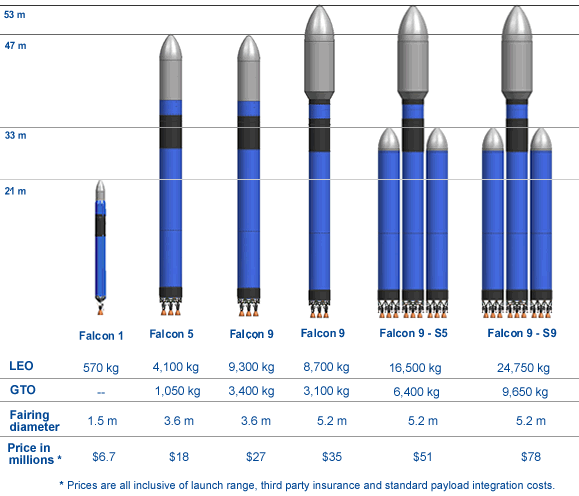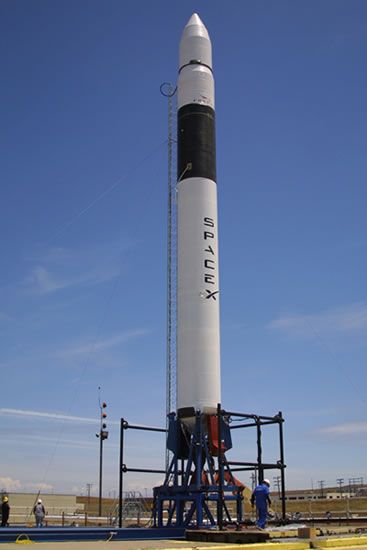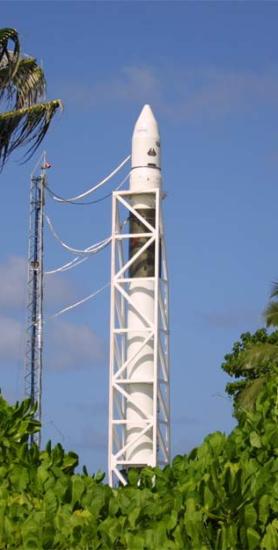SpaceX Falcon
Developed by Space Exploration technologies (SpaceX), the Falcon series of launch vehicles provides a low cost launching facility through the use of standardized engines which are clustered to achieve a desired launch vehicle. Its objective is to provide low cost launch vehicles and it is intended that the first stage will be re-usable after a return by parachute and a water landing. The launch vehicle makes use of existing materials and components but the liquid fuelled Merlin and Kestrel rocket motors are newly developed.
 |
| Image: SpaceX |
| Falcon Family |
Falcon 1
The Falcon 1, which has a total length of 21.30 m, is a two stage vehicle with a capacity to place payloads of 570 kg into a low-Earth orbit.
 |
 | |
| Photos: SpaceX | ||
| Falcon 1 | ||
| Stage | Length | Diameter | Engine | Fuel | Thrust |
|---|---|---|---|---|---|
| 1 | 1.70 m | 1 Merlin | Lox/Kerosene | 342 kN | |
| 2 | 1.70 m | 1 Kestrel | Lox/Kerosene | 31 kN |
Specifications for Falcon 1
The Falcon 1 was first launched on 24 March 2006 from Omolek Island in the Pacific Ocean but the launch failed due to a leak in one of the fuel tanks.
Falcon 5
The Falcon 5 is an intermediate class launch vehicle with a capability to place 4100 kg into a low-Earth orbit. It uses a larger diameter structure that can house the five first stage engines. The use of five engines means that, in some flight scenarios, as many as three engines can be lost without the loss of the mission. Both stages of the Falcon 5, which has a length of 47 m, are fully recoverable.
| Stage | Length | Diameter | Engine | Fuel | Thrust |
|---|---|---|---|---|---|
| 1 | 3.60 m | 5 Merlin | Lox/Kerosene | 1890 kN | |
| 2 | 3.60 m | 1 Kestrel | Lox/Kerosene | 31 kN |
Specifications for Falcon 5
No flight dates have been set for the Falcon 5.
Falcon 9
The Falcon 9 version is a development of the Falcon 5 but uses 9 engines in the first stage to give it a capability to place 9300 kg payloads into low-Eartyh orbit, bringing it the same class as the Atlas and Delta launch vehicles. The Falcon 9 will have a total length of 53 m.
| Stage | Length | Diameter | Engine | Fuel | Thrust |
|---|---|---|---|---|---|
| 1 | 3.60 m | 9 Merlin | Lox/Kerosene | 3400 kN | |
| 2 | 3.60 m | 1 Merlin | Lox/Kerosene | 409 kN |
Specifications for Falcon 9
Further potential developments are the addition of two 5 engined and 9 engined strap-on stages which will increase the payload capacity to 24750 kg into low-Earth orbit, or 9650 kg into a geostationary orbit. The first flight of a Falcon 9 is scheduled for 2007.
Back to Directory of U.S. Military Rockets and Missiles, Appendix 3
Last Updated: 15 April 2006